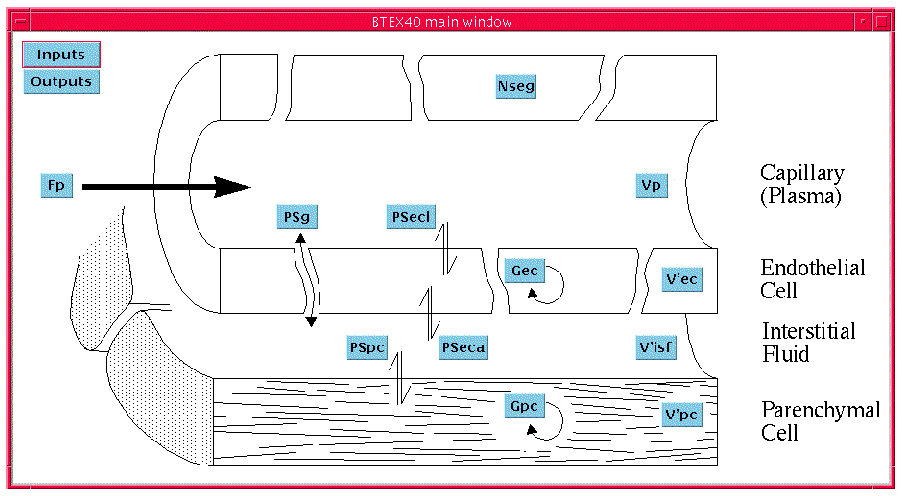Model: BTEX40, a single capillary 4-region 3-barrier blood-tissue exchange model
See Model Demonstrations with parameter sets:
2. IMPORTANT !!! To run demonstration, enter "xhost +nsr.bioeng.washington.edu" in one of your windows to allow the demonstration program to open windows on your machine !!!
BTEX40 is parameterized as follows:
Access to all variables is accessible by clicking the "INPUT" button on the main model page or by selecting "Inputsunder the "Parameters" menu.
Output variables are given by:
|
The mean transit time of the BTEX40 unit, equals sum of connect volumes divided by the Flow and converted to seconds. |
To plot results, select "Plot Area 1" from the Results menu. Place the cursor in an unused box nder Y-parameters and pressing the right mouse button will bring up a list of plottable parameters.

6. Model Demonstrations with parameter sets:
The user should inspect the input parameters and the output curves. Output curves can be found under the Results button.
The following parameter sets are can be demonstrated by clicking on them:
6.1. Just the capillary is in use, no exchange into other regions: just_capillary.par
The output is just the input curve with a time delay of 1.8 seconds.
6.2. Capillary with diffusion: capillary_with_diffusion.par
The model is run twice. The first time is without diffusion in the plasma. The second time is with diffusion in the plasma. Multiple model runs are done by clicking on the "Model" Button, pulling down the menu and activating the "Run Config" button. Activate the "Inner Loop" button to see what parameters are being set.
6.3. Capillary plus isf +ec+pc, typical curve: all_exchange_regions.par
First just the capillary region, then the capillary + isf, then capillary + isf + ec, and finally Capillary + isf + ec + pc regions are all used, and their effect on the outflow is shown.
6.4. Comsumption in the cell versus consumption in the parenchymal cell: consumption_ec_vs._pc.par
The effects on outflow of (1) no consumption, (2) consumption in just the endothelial cell, and (3) consumption in just the parenchymal cell are plotted.
6.5. Optimization of data: btex40.opt.par
Open the results window to see data. Run model. Under Model (Upper Left), select "Optimize config ...". This will bring up the optimization window showing the details on the optimization. Go back to the main window and click on Optimize. Then run the model to see curve fit.

